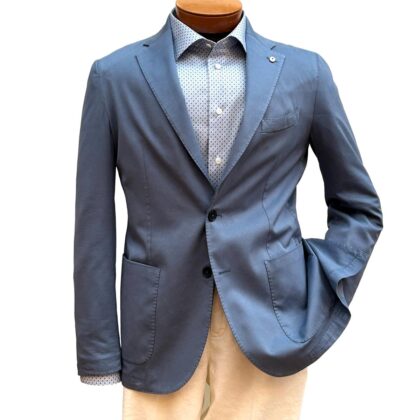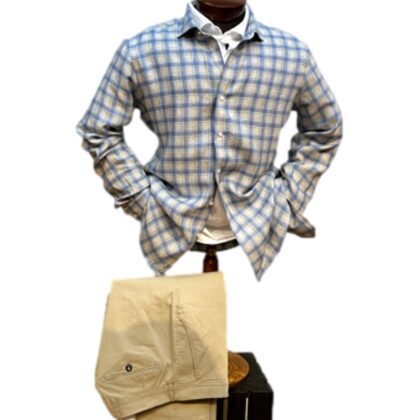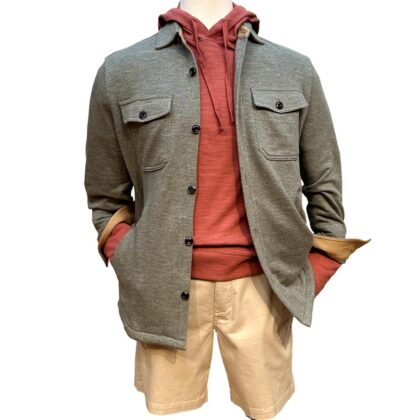Men’s Business Casual Outfits
Men’s Business Casual Outfits
Your Complete Guide to Mastering the Perfect Balance of Professional and Relaxed
Navigating the ambiguous world of business casual can feel overwhelming. Business casual means striking a balance between professionalism and comfort, allowing for versatile outfits like button-up shirts, chinos, blazers, and even dark jeans. You want to look professional enough to be taken seriously, but not so formal that you appear rigid or out of touch. Many people struggle with the business casual dress code, which differs from other dress codes by offering more flexibility while still requiring a polished appearance. We understand the daily struggle of wanting to make a good impression while expressing your personal style – and we’ve created the ultimate solution.
Men’s Business Casual Outfits
-
Soft Jacket from Lubiam
$1,435.00 -
Summertime is Linen time
$613.00 -
Weekend Casual Ensemble
$394.00 -
Pique Cotton Vest for Spring
$1,110.00
Why Choose Business Casual Outfits?
Business casual gives you significant advantages over both traditional formal wear and overly casual options. When considering business casual for men, these benefits become especially clear. Here’s what you gain:
- Professional Flexibility – Command respect in any business setting without the constraints of a full suit
- Personal Expression – Showcase your unique style while maintaining appropriate workplace boundaries
- Enhanced Comfort – Enjoy increased mobility and comfort without sacrificing polish or professionalism
- Versatile Wardrobe – Create dozens of distinct looks from just a few well-chosen pieces
- Confidence Boost – Eliminate morning wardrobe anxiety with foolproof outfit formulas for any occasion
Building your Business Casual Outfits Step-by-Step
Follow these three simple steps to transform your approach to business casual and eliminate the guesswork from your daily routine.
Step 1: Build Your Foundation
Start with essential pieces that form the backbone of any business casual wardrobe. “Begin with quality basics like well-fitted dress shirts, tailored trousers, and versatile dress shoes—no fashion degree required.”
The foundation of any successful business casual wardrobe starts with investing in quality pieces that work across multiple settings. It is important to make sure to choose the correct clothing color palette that works for you. This includes:
- 3-5 quality dress shirts in neutral colors (white, light blue, light grey)
- 2-3 pairs of tailored trousers or business casual pants
- 1-2 optional blazers for more formal settings
- Button ups, which are a polished and versatile choice, offering a step above casual T-shirts and pairing well with chinos, blazers, or sweaters for a neat, professional look
- Quality leather dress shoes (oxfords, loafers, or brogues)
- Business casual shoes such as loafers, leather sneakers, or driver shoes, which strike a balance between professional and casual and complement a variety of outfits like chinos, polo shirts, or blazers
- Versatile accessories like a quality watch and belt
A crisp white shirt paired with navy or grey tailored trousers creates the perfect blank canvas for business casual outfits. While a navy suit is a classic and more formal option, business casual basics allow for greater versatility and comfort in most office environments. From there, you can adapt and customize based on your workplace environment and personal preferences.
Step 2: Mix and Match
Learn the art of combining your foundation pieces to create numerous professional looks. “Our intuitive outfit formulas show you exactly how to pair items for maximum versatility and impact.”
The beauty of business casual lies in its ability to create dozens of distinct looks from relatively few pieces. Here are some foolproof formulas:
- Classic Business Casual: Dress shirt + tailored trousers + leather shoes
- Elevated Business Casual: Dress shirt + blazer + tailored trousers + leather dress shoes
- Relaxed Business Casual: Polo shirt + chinos + leather shoes or minimalist sneakers
For relaxed business casual work attire in certain workplaces, you can wear sneakers as part of your business casual look, provided they are clean, minimalistic, and stylish. This option is increasingly common in modern office environments, but always ensure your sneakers maintain a polished appearance.
The key to mastering the mix-and-match approach is balancing more formal elements with more relaxed pieces. If you’re wearing jeans (which should be dark wash and well fitted), pair them with a tailored shirt and possibly a blazer to maintain professionalism.
Step 3: Adapt for Any Occasion
Customize your look based on specific workplace scenarios and seasonal changes. “Watch as wardrobe uncertainty transforms into confident style choices that perfectly match any business situation.”
Business casual offers exceptional flexibility to adapt to different situations:
- Client Meetings: Opt for higher-end business casual with a blazer, dress shirt, tailored trousers, and leather shoes
- Regular Office Days: Standard business casual with a dress shirt, chinos, and leather shoes makes for a polished look
- Casual Fridays: A more relaxed approach with a polo shirt or casual button-up, dark wash jeans, and clean footwear strikes the perfect blend of casual while maintaining professionalism
- Seasonal Adjustments: Layer with sweaters in winter, opt for lighter fabrics in summer, but always maintain the same level of put-together appearance
When building your business casual wardrobe, remember that a t shirt is generally not suitable for business casual settings, as it lacks the structure and formality needed for a polished, professional look. Business casual is not the same as casual attire for men—while relaxed attire may be acceptable in some workplaces, it should still be appropriate and polished, avoiding overly casual items like shorts or graphic tees.
What Makes the Business Casual Dress Code Different?
Business casual offers unique advantages that traditional formal wear simply can’t match. Men’s business casual is especially versatile, allowing for a relaxed yet professional appearance that suits a wide range of workplace environments.
- Perfect Balance – Strikes the ideal middle ground between overly formal suits and too-casual weekend wear, finding the sweet spot that works across most professional settings
- Seasonal Adaptability – Easily adjusts to weather changes while maintaining a consistent professional image through smart layering and fabric choices
- Occasion-Appropriate Flexibility – Seamlessly transitions from formal meetings to casual Fridays with minor adjustments while balancing professionalism and comfort
- Professional Versatility – Works across various industries and office settings while allowing employees to express personal style within appropriate boundaries. Men’s business casual attire continues to evolve, offering updated options like polo shirts, chinos, and different footwear choices to meet the needs of modern offices.
The fine line between business casual and smart casual can sometimes cause confusion. Business casual tends to lean more toward the professional side, while smart casual may incorporate more relaxed elements. When unsure, it’s preferable to be a bit overdressed rather than underdressed in business casual settings.
Essential Items for Business Casual Outfits
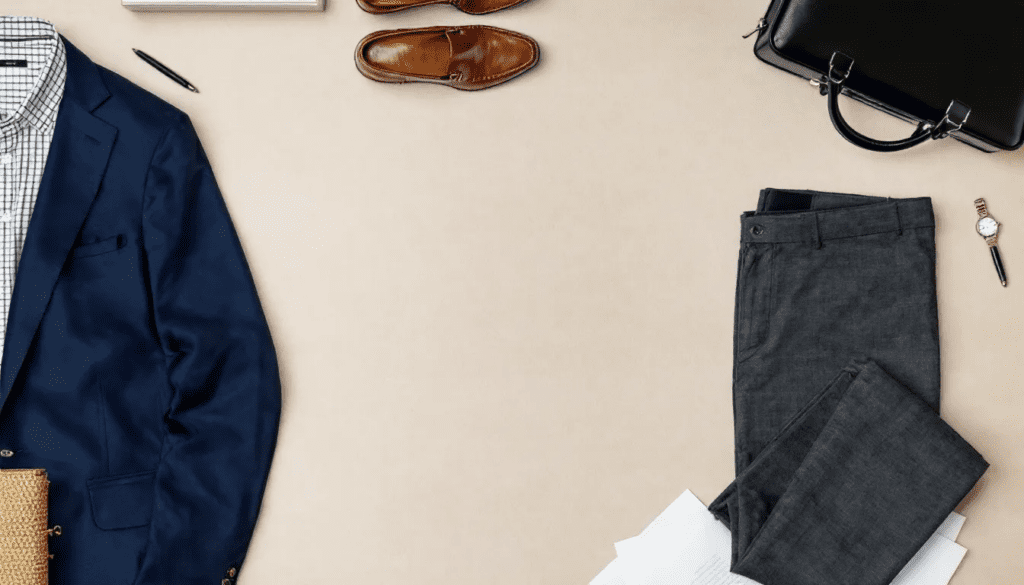
Building a versatile business casual wardrobe starts with a few essential pieces that can be mixed and matched for countless business casual outfits. Here’s what every professional man should have on hand:
- Dress shirts: Invest in several high-quality dress shirts in solid colors like white, light blue, or subtle patterns. These are the foundation of any business casual outfit and can be dressed up or down depending on the occasion.
- Dress pants: Tailored dress pants in neutral colors such as navy, black, or gray are a must. They pair effortlessly with a variety of tops and help create a polished, office-appropriate look.
- Business casual pants: Chinos or trousers in shades like light gray, beige, or navy add variety to your business casual wardrobe and work well for more relaxed office environments.
- Blazers or sports coats: A tailored blazer or sports coat instantly elevates your business casual outfit, adding structure and sophistication without the need for a full suit.
- Polo shirts: A few well-fitted polo shirts in solid colors or subtle patterns are perfect for warmer days or more laid-back business casual settings.
- Leather dress shoes: High-quality leather dress shoes—think oxfords, loafers, or brogues in black or brown—are essential for completing your business casual look.
- Belt: A simple leather belt in a matching tone keeps your outfit cohesive and adds a touch of polish.
- Watch: A classic watch is a subtle way to add sophistication and show attention to detail.
- Socks: Don’t overlook socks—choose high-quality pairs in neutral colors to complement your business casual outfits.
With these essentials, you’ll have the flexibility to create a wide range of business casual looks that are both stylish and professional.
Accessorizing a Business Casual Outfit
The right accessories can take your business casual outfit from basic to standout—without ever crossing the line into overdressed. Here’s how to accessorize with confidence:
- Keep it simple: Less is more. Stick to one or two key accessories to maintain a clean, business casual look.
- Add a pop of color: A pocket square or a patterned tie can inject personality into your business casual outfit, especially for a formal meeting or when you want to make a memorable impression.
- Mix and match: Don’t be afraid to pair a leather belt with a metal watch or experiment with subtle patterns in your socks or pocket square. Just keep the overall look cohesive.
- Consider the occasion: For important meetings, opt for more formal accessories like a tie or a classic pocket square. For everyday business casual, a sleek watch or understated belt is all you need.
- Personalize your outfit: Accessories are a great way to express your personal style while still maintaining professionalism. Choose pieces that reflect your taste but don’t distract from your overall appearance.
Thoughtful accessorizing is the secret to a business casual outfit that feels uniquely yours while remaining office appropriate.
Seasonal Business Casual
Business casual attire isn’t one-size-fits-all—your business casual outfit should adapt with the seasons to keep you comfortable and stylish in any business casual setting.
- Spring: Embrace lightweight fabrics and fresh colors. Pastel dress shirts, chinos in light gray or beige, and subtle patterns can add a touch of energy to your business casual wardrobe.
- Summer: Stay cool with breathable fabrics like linen, cotton, or seersucker. Opt for light colors and short-sleeve polo shirts, and keep your business casual attire relaxed but still polished.
- Fall: Transition to richer fabrics and earthy tones. Layer a tailored blazer over a dress shirt, and choose business casual pants in deeper shades like olive, burgundy, or charcoal for a sophisticated seasonal update.
- Winter: Prioritize warmth with thicker fabrics such as wool or flannel. Darker colors and smart layering—think sweaters over dress shirts and under blazers—will keep your business casual outfit sharp and comfortable in colder months.
No matter the season, the key is to maintain a business casual look that’s both functional and professional for your workplace environment.
Do’s and Don’ts of Business Casual
Mastering business casual attire means knowing what works—and what to avoid. Here are some essential do’s and don’ts for any business casual setting:
Do:
- Dress for the occasion: Always consider your industry, workplace, and the specific event when choosing a business casual outfit.
- Keep it polished: Make sure your business casual attire is clean, ironed, and fits well for a put together appearance.
- Add a personal touch: Use accessories and subtle patterns to showcase your personal style without sacrificing professionalism.
Don’t:
- Overdo it: Avoid over-accessorizing or wearing too many bold patterns and bright colors, which can distract from your overall appearance.
- Be too casual: Steer clear of t shirts, athletic sneakers, or ripped jeans—these don’t belong in a business casual setting.
- Sacrifice professionalism: Even in a more relaxed office environment, your business casual outfit should always project respect and
Business Casual Levels
Choose the approach that best matches your workplace environment and personal goals.
🛠️ Starter Level – Essential pieces for those new to business casual at minimal investment
This includes the absolute basics: 2-3 quality dress shirts, 2 pairs of dress pants or chinos, and one pair of versatile leather shoes. Perfect for those just entering the professional world or transitioning from more casual or more formal environments.
💼 Professional Level – Expanded options for versatility across different workplace scenarios
Build on your foundation with: 5-7 dress shirts in various colors and subtle patterns, 3-4 pairs of trousers in neutral tones, dark wash jeans for appropriate settings, 1-2 blazers, and 2-3 pairs of quality shoes. This provides enough variety for a full work week without repetition.
🏆 Executive Level – Premium additions that signal attention to detail and leadership presence
Elevate your business casual wardrobe with: Tailored blazers in multiple colors, premium dress shirts with refined details, tailored trousers in various fabrics, high-quality leather dress shoes, and thoughtful accessories like pocket squares and a tie bar for occasions that require a more polished look.
Frequently Asked Questions (FAQ)
🔹 What exactly qualifies as business casual for men?
Business casual bridges the gap between formal business attire and casual wear—typically including dress shirts, tailored trousers, and leather shoes without requiring a full suit and tie. The exact interpretation varies by industry and company culture, but maintaining professionalism is always essential.
🔹 Can I wear jeans in a business casual environment?
Dark wash, well-fitted jeans without distressing can work in many modern business casual settings, especially when paired with dressier top elements like a crisp button-up and possibly a tailored blazer. However, some traditional offices still consider jeans too casual, so observe your specific workplace environment.
🔹 Are sneakers appropriate for business casual?
Minimalist, clean leather sneakers can work in more relaxed business casual environments, but traditional leather shoes are always a safer choice. If you opt for sneakers, they should be simple designs in neutral shades without bright colors or athletic styling. Boat shoes may also be acceptable in more laid-back settings.
🔹 How can I add personality to my business casual outfits?
Accessories like quality watches, subtle pocket squares, and tasteful socks offer opportunities for personal expression while maintaining professionalism. You can also incorporate subtle patterns and textures in shirts and blazers to create visual interest without sacrificing your overall professional appearance.
🔹 Is a polo shirt appropriate for business casual?
Yes, a polo shirt can work well in business casual settings, especially in more relaxed office environments or warmer weather. For the most professional look, choose polos in solid colors or minimal patterns, ensure they fit well, and pair them with dressier elements like tailored trousers to balance the casual nature of the polo.
🔹 What’s the difference between business casual and smart casual?
Business casual typically leans more toward professional attire, while smart casual allows for more relaxed elements. Business casual generally requires a dress shirt or polo shirt, tailored trousers or chinos, and leather shoes. Smart casual might include t-shirts, jeans, or even certain types of sneakers. When in doubt in a business casual setting, err on the side of being slightly overdressed.
Elevate Your Professional Image Today
The short answer to the business casual question is simple: it’s about finding that perfect blend between professional and comfortable. By mastering the principles outlined above, you’ll create a cohesive appearance that works across various office settings while still allowing for personal expression.
Business casual attire doesn’t have to be complicated. Start with quality foundation pieces, learn to mix and match effectively, and adapt your approach based on your specific workplace environment. The entire look should project competence and professionalism while offering more comfort and flexibility than traditional formal business wear.
Whether you’re navigating a more relaxed office environment or looking to update your work wardrobe, these business casual principles will ensure you make the right impression. The difference between appearing polished versus thrown-together often comes down to understanding a few simple rules and applying them consistently.
Remember that being slightly overdressed is always better than being underdressed. A tailored blazer can make all the difference in elevating your business casual look for important meetings or presentations, and can easily be removed for after-hours gatherings.
Need Help Creating the Perfect Outfits?
Work one-on-one with a Family Britches stylist to create outfits that fit your style, your life, and your closet. Meet in-person or virtually.
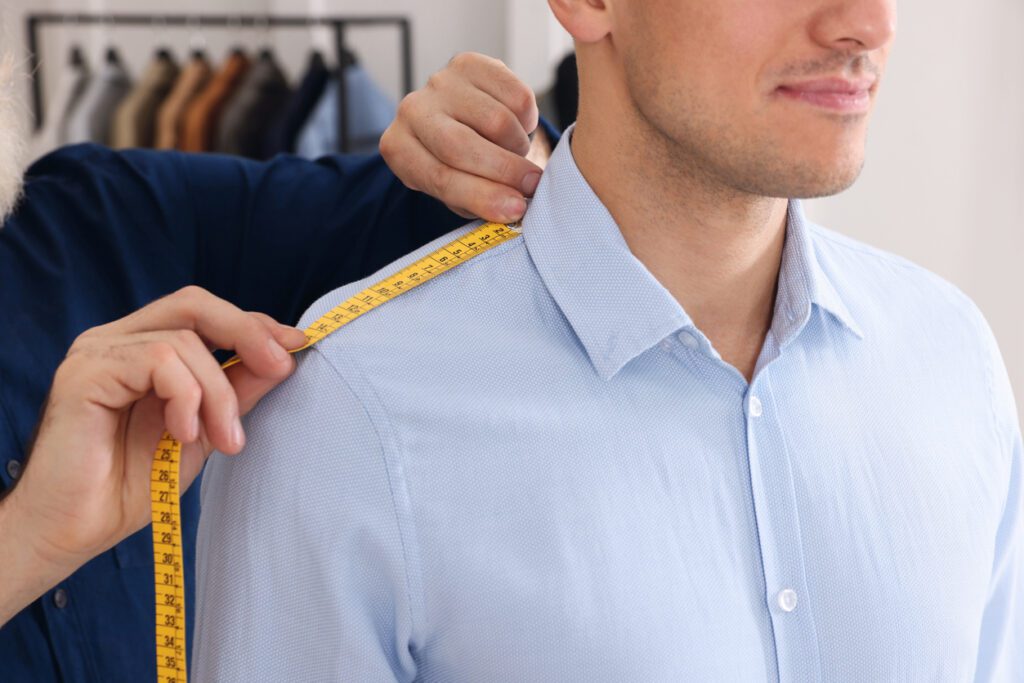
CUSTOMER CARE
FEATURED COLLECTIONS
SERVICES & SPECIALS
STORE LOCATION
70 King Street
Chappaqua, NY 10514
(914) 238-8017
Hours & Directions
99 Main Street
New Canaan, CT 06840
(203) 966-0518
Hours & Directions
Copyright © Family Britches, Inc. All Rights Reserved. Website By Webpilot.

